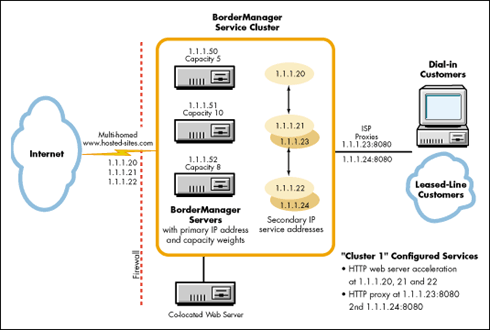BorderManager Proxy Cache Clustering
Articles and Tips: article
01 Nov 1998
A Low-Cost Solution for High-Availability ISP Services
 As an ISP, your customers are unforgiving. They hate slow response times, and they won't stand for Internet service disruptions of any kind. With all the competing ISPs to choose from, your customers will simply go elsewhere if you can't provide trouble-free service.
As an ISP, your customers are unforgiving. They hate slow response times, and they won't stand for Internet service disruptions of any kind. With all the competing ISPs to choose from, your customers will simply go elsewhere if you can't provide trouble-free service.
So how can you provide high-availability services without paying through the nose for high-end failover solutions? How can you gain additional load balancing, easier management, and the scalability that will allow you to take on thousands of new customers while enhancing both the quality and quantity of services you provide?
Clustering to the Rescue
Figure 1: Example of BorderManager service cluster configuration.

The answer is Novell BorderManager proxy cache clustering. This new technology promises to give ISPs virtually 100 percent uptime. With proxy cache clustering, two or more BorderManager servers are configured together to act as one. If one server in a clustered system fails, the other BorderManager server(s) immediately take over the failed server's TCP/IP address and connections.
The benefit to you is that your technicians can service the downed server at their convenience, without disrupting service. What's more, the cluster will dynamically reconfigure and balance your existing addresses over the new server(s)-giving you outstanding load distribution and automatic hit diffusion.
The cluster in Figure 1 consists of three BorderManager servers. Each server is given a primary IP address used for cluster management. Each server is also given a capacity weight that determines how services will be distributed among the servers. The services themselves are attached to secondary IP addresses that can be assigned to any server in the cluster and easily be moved to another server in case of server failure.
This example cluster is configured with two services. On the public side, BorderManager provides HTTP Web server acceleration of the co-located Web server. This service is attached to three secondary addresses: 1.1.1.20, 21, and 22. The host name, www.hosted-sites.com, is advertised on all three addresses via DNS to provide a multi-homed Web service. When the cluster is operational, the three secondary IP addresses and their associated services are spread across the clustered servers and use DNS rotation to handle approximately one-third of the load each.
On the private side, BorderManager provides HTTP proxy caching for your users' Internet access. This service is attached to two secondary IP addresses balanced across the two servers with the highest capacity. Since each server has been assigned one-third of the public load, the server with the highest capacity weight assumes the new service.
Each of the cluster servers actively monitors the state of the cluster. When a server fails, the remaining cluster servers immediately assume the failed server's secondary IP addresses and associated services.
With BorderManager proxy cache clustering, you'll be ready for any level of business expansion, and you won't have to pay dearly for expensive, labor-intensive Web servers. All you need is an additional BorderManager proxy cache server or two, and secondary IP addresses.
And because BorderManager is Novell Directory Services® (NDS)-enabled, it gives you streamlined, centralized management that can cut your administrative hassles and costs dramatically. You get a single point of administration from anywhere in your network.
Conclusion
The ISP industry is becoming more and more competitive with every passing day. Quality of service will be the key differentiator that makes or breaks ISPs. Novell can help you configure a BorderManager proxy cache cluster that adds exceptional fault failover, scalability, load balancing, and centralized management to your infrastructure—without requiring additional investment in expensive hardware.
Like all Novell network services, Novell BorderManager proxy cache clustering will work with whatever applications you're using and will run on low-cost commodity hardware. It has the capacity to revolutionize the way you do business.
For more information and news of product availability, visit Novell's BorderManager Web site at
http://www.novell.com/products/bordermanager/
— Ron Lee
Copyright © 1998 by Novell, Inc. All rights reserved. No part of this document may be reproduced or transmitted in any form or by any means, electronic or mechanical, including photocopying and recording, for any purpose without the express written permission of Novell.
All product names mentioned are trademarks of their respective companies or distributors.
* Originally published in Novell AppNotes
Disclaimer
The origin of this information may be internal or external to Novell. While Novell makes all reasonable efforts to verify this information, Novell does not make explicit or implied claims to its validity.